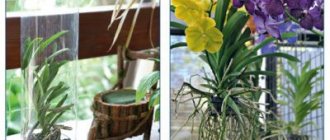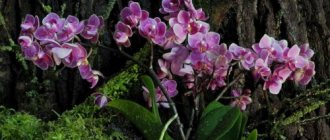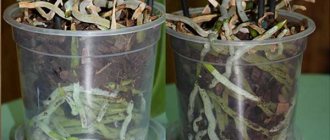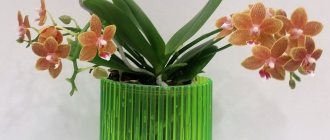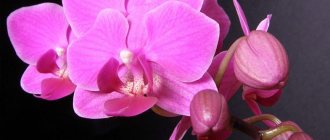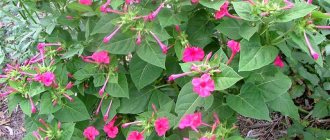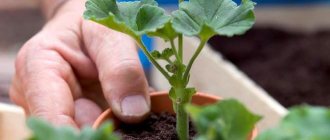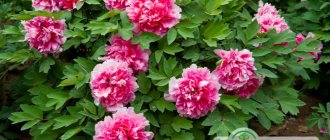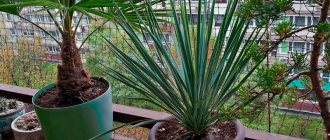Beautiful orchids are welcome guests in the house. Their exquisite beauty, graceful flowers and richly colored leaves will add a touch of elegance to the interior. An orchid in a vase without soil, in a glass flask, looks especially sophisticated. The drainage structure and massive roots are visible through it. In addition to aesthetics, choosing a transparent vessel for an orchid has practical benefits - the roots of this plant participate in photosynthesis, which means they need sunlight. Is it possible to plant a delicate orchid in a glass pot, and how to choose it - you should take into account all the nuances.
Contents in flasks
The difference lies not only in their beautiful blooms, but also in their breeding methods. While many flowers grow on the ground, orchids grow from tree bark, clinging to it. They obtain useful components and moisture with the help of aerial roots. Moisture comes from the air or fog, and useful components from their residues that accumulate in the tree bark. But this process occurs in the humid tropics, where the habitat for orchids is very suitable. It is impossible to create such an atmosphere in indoor conditions. There is more than one method for growing an orchid:
- growing in water - hydroponics;
- orchid without substrate and liquid;
- breeding in soil.
If the roots of the plant are constantly in liquid, they will begin to rot. Therefore, they should not be completely submerged, but rather be above the liquid. It is not necessary to switch to keeping it in a flask right away, especially for the flower itself:
- First you need to pull it out of the ground, clean the roots, put it in water for a couple of days, and then dry it the next day. You do not need to drain the liquid completely, but so that one centimeter of the roots are still immersed in it.
- After a week, the orchid can be left in the water for several days, but one day should be allowed to dry.
- Afterwards, leave the phalaenopsis in the water for the entire time, changing it and observing the condition of the roots. If they change color to silver, it means the flower needs to be watered.
At this time, the growth of new aerial roots will be noticeable, and green shoots will begin to appear on the old ones.
Please note! With this method, growing may be difficult due to rot on the roots. To cope with it, you need to take the flower out of the water for a day and treat the roots with a fungicide. If algae appears on them, then you should not get rid of them, as this helps air exchange
A small part of the roots dies off if the habitat has changed to aquatic, and instead of them appear those that are adapted for the plant to stay in water
If algae appears on them, then you should not get rid of them, as this helps air exchange. A small part of the roots dies off if the habitat has changed to aquatic, and instead of them, those adapted for the plant to stay in water appear.
To prevent the appearance of fungus, you need to use semi-hydroculture - an unusual substrate that does not provide the flower with any nutritional components, but keeps it in a standing position. The flower receives all its nutrition through fertilizers, which are diluted in water. They are easily digestible, and therefore do not waste a lot of energy, directing it to development.
Planting in hydroponics
First you need to take a plastic pot with drainage holes, which are needed to allow water and other nutrients to flow to the roots of the flower. If you use expanded clay as soil, then before planting the orchid, thoroughly rinse its roots to remove the old soil and then dry them. Afterwards, fill the pot halfway with expanded clay, plant the crop in it and cover it with soil to the very top.
If expanded clay with perlite is used as a soil, then fill the expanded clay first, then place the flower in it and fill it with perlite on top. To strengthen this mixture, immerse the container in water. You can add small pebbles on top of the soil to decorate the glass bottom of the aquarium.
If you use diatomite and expanded clay as soil, then fill the diatomite first, then place the flower in it and cover it with expanded clay on top. To strengthen the mixture, also immerse the pot in water.
It is possible to grow an orchid without soil, and for this they use semi-hydroculture. Place it in any transparent container and pour in a little liquid, which, under the influence of capillary forces, rises to the roots, allowing them to be saturated with moisture and dissolved nutrients.
When a crop is planted in water, the roots are well ventilated above its surface. The flower is not attacked by those pests that would encounter it in the soil, and it will not wither if there is a lot or little feeding. A crop planted and grown in this way does not require replanting.
In order for growing orchids in water to be successful, you need to know that not all varieties are suitable for this. Many gardeners use those species that do not need a period of rest and periodic drying of the root system:
- Phalaenopsis and other indoor varieties;
- Dendrobium, which grows best in a cool room;
- Cattleya, she likes warm temperatures, but not heat;
- Zygopetalum.
Possible problems
Beginning gardeners may encounter a number of difficulties when growing an unusual plant. Ignoring the problems that have arisen can lead to his death. Experts highlight a list of the most common problems when growing orchids and ways to solve them.
- Rotting of foliage - improper watering. If the trunk is damaged by rot, the plant cannot be saved.
- Wilting is damage to the root system by dangerous insects.
- The appearance of mold deposits is due to low light levels.
- Mechanical damage to the root system is a violation of transportation rules.
- Root rotting is a violation of the watering regime.
- Musty smell – non-compliance with ventilation rules.
- Salt deposits and algae - failure to comply with sanitary standards and irregular washing of the vessel.
- The soft structure of the foliage means the presence of infection in the substrate or drainage.
Particular attention should be paid to the most common diseases of this plant:
- spotting;
- fusarium;
- bacterial rot;
- viral diseases.
Among the dangerous insects, the following species should be highlighted:
- thrips;
- scale insects;
- mealybug;
- spider mite
For information on how to properly transplant an orchid into a glass flask, see below.
Care
Let's consider caring for an orchid in glass at home. Caring for a plant in a glass vase is not very different from traditional caring for an orchid in a substrate, but it does have a number of nuances that you need to know about and take into account. First of all, this concerns:
- The vase itself;
- Her material;
- Forms;
- And the place of residence of the plant.
Watering
Watering a plant in a glass vase is no different from watering an orchid growing in an ordinary pot or flowerpot. The procedure is simple: you need to carefully pour water into the vase in such an amount that the roots are completely immersed and moistened. Water should be:
- Soft;
- Seated;
- With minimal content of mineral salts.
This is important, first of all, for the delicate roots of the orchid, and will also help preserve the decorative appearance of the glass. After all, mineral salts form a deposit after the water evaporates, which is clearly visible and does not look very attractive.
Advice! It is ideal to use rain or melt water, of course, only if the precipitation collection process was carried out in an ecologically clean region.
After 30-45 minutes, the water must be carefully drained
Do this with extreme caution because:
- Wet glass is very slippery;
- The vase may accidentally slip out of your hands;
- Break and injure you or others with fragments.
Make sure that there is no water left in the container after draining. The average watering frequency is:
- 2-3 times a week in warm weather;
- And once a week, if it’s cloudy outside.
It is always necessary to monitor the plant and take into account its current needs. On hot summer days, watering can be daily. It is better to choose the time for the procedure in the first half of the day, so that by the evening the plant has time to dry.
Feeding and pest control
Under natural conditions, fertilizing occurs naturally, when rain washes off the humic substances formed on the surface of the tree bark directly onto the roots of the epiphyte. Therefore, when grown indoors, these plants require competent and dosed feeding.
It is better to feed the orchid after flowering.
The most important thing to remember is that it is better to fertilize frequently with a weak solution of fertilizers than to fertilize infrequently with a strong one. This is also explained by the same features of feeding orchids in nature. After all, rain in the tropics does not wash away a very rich layer of substances, but it does so quite often.
In practice, this means that during the period of active growing season and growth of green mass, the orchid should be fed with liquid fertilizers once every 1-2 weeks at ¼ of the concentration indicated on the package.
Advice! Before the procedure, it is necessary to moisten the roots of the plant with water to minimize the risk of burns from the fertilizer solution. Foliar feeding, alternating with root feeding, has proven effective.
Pest treatments are carried out with diluted insecticides from a sprayer. Use a fine mist sprayer. It is necessary to process all parts of the plant (on all sides), except for flowers.
How to monitor the health of the roots?
The best disease prevention is to maintain plant hygiene at an optimal level. In this case it is necessary:
- Select a container size sufficient for the plant’s roots to fit freely inside;
- There was also the possibility of ventilation and free access of air inside.
Unacceptable:
- Hypothermia of roots;
- As well as debris and dirt inside the vase.
Remove dead leaves and roots from the plant promptly.
Ventilation
It is enough to periodically remove the plant from the container and leave it in free space for some time. You can do this:
- While swimming;
- Or when you need to wash a vase from accumulated dirt.
Attention! Sometimes orchid roots can stick to the walls of the vase, so care must be taken when removing the plant from the container.
Do I need to replant?
Many gardeners, having received a flask with orchid seedlings, wonder whether they need to be replanted immediately? There are more than a dozen orchids in one container brought from Asian countries, so replanting is necessary, but this cannot be done right away - the plants must adapt.
Place the flask in a bright and warm place for 2 weeks, and only after this time can you start planting the seedlings in separate pots.
An orchid from a flask is transplanted in stages:
- “Acclimatization” – relieving stress in plants after a difficult move.
The flask should be installed on a windowsill flooded with sunlight, and care should be taken to ensure that there are no drafts or strong temperature changes. So the flask should last 2 weeks. Seedlings can be transplanted without acclimatization only if the flask is turned over during transportation and the contents are mixed. It is worth doing the same if the flask for plants has become too small. - Replant in compliance with all safety measures.
- Arrange for proper care.
Treatment
The vase must be washed periodically, as the following accumulates on the inner walls:
- Algae layer;
- And mineral deposits.
The disinfection procedure or prevention can be carried out using:
- A weak solution of potassium permanganate (of course, the plant should be removed);
- Or fungicides.
This orchid is susceptible to diseases such as:
- Spotting, which may be caused by excessive moisture in the substrate or air. In diseased plants, wart-like spots form on the underside of the leaf. It is often caused by fungal diseases that actively develop in warm and damp rooms. In this case, rounded black spots appear on the upper side of the leaves. Orchids fight spotting by creating a favorable environment for the flower. When planting plants, the substrate is disinfected. Water Wanda with water in which special antifungal drugs such as Trichodermin or Fitosporin are dissolved.
- Rot caused by waterlogging of the substrate. Most often, the disease progresses on cool days or when using containers that are unsuitable for the orchid. With this disease, rotting of roots and stems is observed. The tissues of the flower soften and turn black. Very quickly the plant turns yellow and dies. To combat this disease, the substrate is disinfected before planting orchids. The plant is watered in accordance with the requirements of agricultural technology. The drug "Maxim" is added to the water.
| Manifestation | Cause | Elimination method |
| Round black markings appear on the leaves along their entire length. | Fungal infection. | Treat infected areas with a fungicide. Reduce the frequency of watering to once a week, maintain a constant temperature of 23... 25 °C. Cover with a cloth, avoid bright light. |
| The horse system rots, becomes covered with a black coating and dies. The stem with leaves dries up. | Bacterial rot. | Remove infected areas and cover cut areas with phytosporin. Replace the soil and disinfect the container. Antibiotics (tetracycline) are also effective in a ratio of 1 gram per liter. |
| Black dots appear on the outside of the leaf, and the stem may become covered with brown lines. | Viral infection. | It is impossible to completely cure. You should get rid of the infected plant to avoid spreading the infection. |
| Small green insects appear throughout the orchid. The stems and leaves wither and the plant dies. | Aphid. | Increase the air humidity, treat the flower with a soap solution or tincture of lemon zest. Special intestinal preparations (Intavir, Actofit) are best suited for pest control. |
| Small beige pests on leaves, flower stalks, buds and stems. White coating and waxy deposits. Wanda is fading. | Mealybug. | Remove growths and affected parts of the plant. Treat the bulb with an alcohol solution and remove the parasites. Aktara, Mospilan, Aktellik, Calypso are excellent for wrestling. |
| Small voids appear on the leaves and stem. Yellow spots appear, shoots die. | Shield. | A solution of soap and alcohol, fern tincture and chemicals such as Permethrin, Bi 58, Phosfamide, Methylmercaptophos will help get rid of the pest. |
Risks of infectious diseases
Causes
The cause of diseases of this kind is the accumulation of pathogenic microorganisms: fungi and bacteria.
To prevent orchid diseases, it needs proper care.
It is enough to imagine a damp basement in a building or a corner of a house on the north side to understand how this happens. Fungi or bacteria gather and multiply in moist, secluded areas. A glass vase without any ventilation is an ideal place in this case.
Prevention
It is necessary to periodically ventilate the plant and the container itself. For epiphytes, access to fresh air is extremely important. In turn, this minimizes the possibility of:
- Stagnation of moist air inside;
- And the appearance of mold, mildew and bacterial colonies.
It is also very important to keep the plant in conditions acceptable to it, that is:
Treatment
accumulates on the inner walls
- Algae layer;
- And mineral deposits.
The disinfection procedure or prevention can be carried out using:
- A weak solution of potassium permanganate (of course, the plant should be removed);
- Or fungicides.
Growing orchids in glass pots (vases)
Although Vanda looks very elegant in this form, such content is very conditional for it. The reason is that only the roots of the plant should be in the flask behind the transparent glass, while the beard should be free to be in the space.
Tall vases are not suitable for these purposes - the plant should not be completely contained in the container, otherwise it suffers from stuffiness, and there is also an increased risk of rotting.
When grown in this way, the orchid suffers from a lack of air.
Microclimate
Keeping them in vases has its advantages. A humid microclimate is formed in the glass flask, which is very beneficial for the roots of the plant, since in nature it grows in a very humid climate. However, you should be careful because the glass cools quickly and can chill the roots. Cold and moisture can cause mold and rot.
As already mentioned, tall, elongated glass pots are not suitable for vanda, but wide, glass-shaped ones will do. The size should be sufficient for the roots to fit freely inside. The plant itself should be on the surface from the base of the rosette, flush with the edges of the vase, and not buried inside. You can secure the vanda in this position with wire.
Attention! You can grow vanda in a plastic container. A large bottle with the top cut off will do.
The use of plastic eliminates the disadvantages of glass - fragility and low thermal conductivity.
Advantages and disadvantages
| pros | Minuses |
|
|
Possible problems and difficulties
Growing orchids in water and regular soil is not always successful. In rare cases, problems may arise:
- The edges begin to wrinkle. The reason is high air temperature. During the day and night, the difference in changing temperature should not exceed 8C.
- Dryness and rotting of the root system. The reason is excessive watering, a pot that is too narrow, squeezing the roots, heavy watering after a long absence of water.
- No flowering. Treatment is heat stress. The difference between the temperature at night and during the day should be 12-14C.
Constantly keeping orchids in water is accompanied by the formation of a disease, the cause of which is pathogenic microorganisms, for example:
- fungi;
- bacteria.
Please note! To prevent problems, you need to properly care for your beauties. The ideal microclimate for fungus is a damp and secluded place, for example, a glass flowerpot in which there is no ventilation. Preventive measures include periodic ventilation of the container
Epiphytes absolutely need air, as it can prevent:
Preventive measures include periodic ventilation of the container. Epiphytes absolutely need air, as it can prevent:
- moisture stagnation;
- mold formation with bacteria.
Phalaenopsis in water needs:
- sufficient lighting;
- maintaining the desired temperature;
- proper watering.
General concept
Shapes, descriptions, container material
Tribes living in the jungles of South America call orchids “daughters of the air.” This expression contains the true meaning of the lifestyle of most species of tropical orchids.
Therefore, we should immediately make a reservation that growing exclusively inside flasks is not suitable for orchids, moreover, it is contrary to their nature.
However, in flower shops you can find epiphytic orchids, the same vandas that are sold in a glass flask. And cultivated orchid seeds are germinated in sterile, sealed containers - bottles, jars and laboratory glassware.
Thus, we can say that most often flasks are of a simple shape in the form of an elongated glass glass or a complex, “traditional” shape with a flat bottom and a narrow neck.
Neither one nor the other is suitable for normal cultivation. Since the plant will suffer from constant stuffiness, being in danger of rotting. You need to find a wide flask in the shape of a cognac glass.
What types of orchids can grow in glass?
Traditional, so to speak, cultivation in a flask, for aesthetic and practical reasons, implies the absence of a substrate or its replacement with a hydrogel. Therefore, epiphytic/lithophytic orchid species that have a highly developed root system can grow in flasks. Taking into account also the fact that the flask has an elongated shape, monopodial species that grow upward are preferable:
- Wanda;
- phalaenopsis (and their hybrids);
- vanilla;
- ascocenda;
- Angrecum;
- brassavola, etc.
Vandas in glass vases.
What is the best way to arrange a flower?
The plant is placed halfway in the flask. That is, only the orchid roots are placed inside a suitable-sized “glass”. The plant itself is located on the surface, in the open air. The base of the rosette should be flush with the edges of the vase, and not be recessed inside. You can secure the plant in this position with wire, or any other available methods and available materials.
Growing seedlings and adult plants
An orchid flask is, in fact, not quite a “flask” in the traditional sense of the word. The container is a tall vase of cylindrical or complex shape, similar to a glass or goblet. They are made of glass and very rarely of plastic.
To germinate seedlings, as usual, various glassware is used, ranging from bottles and jars to laboratory glassware of various shapes and volumes. The only conditions for which are: transparent glass and the possibility of hermetically sealed.
Such flasks are a temporary refuge for orchids, since germination does not depend on the volume of the container, and, at the same time, requires sterile conditions. Such containers are not suitable for growing adult plants, at least in one respect – size. Considering the complex shape, fragility of thin glass and the presence of narrow necks, you can safely cross them off the list of candidates for “housing” an orchid.
Orchid seedlings in a flask.
As has already been noted several times above, for an orchid it is necessary to find a flask of a suitable size, similar in shape to a cognac glass. And even though the blooming vanda behind the glass of a tall, glass-like flask looks very elegant, such content suits it only conditionally.
How to care for an orchid in a flask?
Keeping an orchid in a vase has its advantages and disadvantages. A humid microclimate is formed and maintained behind the glass of the flask, which in turn is very useful for the root system of the epiphyte, since in nature they grow precisely in such conditions.
A significant drawback is the rapid cooling of the glass, which can cool the roots. And cold and moisture, as you know, are very harmful to orchid roots and can provoke the appearance of mold and rot.
In addition to the low thermal conductivity of glass, there is its fragility and high rate of contamination - with limescale, colonies of algae and fungi.
Advice! The disadvantages of glass are offset by another material – plastic. Even a plastic bottle with the top cut off may work.
You need to know about all these features of materials and shapes before placing the plant in such a container. If this does not stop the grower and a similar experiment is planned, it is also necessary to know about proper care in specific conditions.
Watering
The watering procedure is no different from what a gardener would do with a plant in a pot and flowerpot. It is necessary to carefully pour water into the flask so that all the roots are immersed. After 30-45 minutes, the water must also be carefully drained. Use rain, melt or filtered water with a minimum amount of dissolved mineral salts.
Watering is done in the usual way.
Attention! Be careful when draining water. The flask can become very slippery, you can drop it and accidentally injure yourself or others with shards of broken glass. After draining the water, you need to make sure that it does not remain in the vase
Watering is carried out as needed, depending on the condition and requirements of the plant. On average, this is 2-3 times a week in warm weather and 1 time in cloudy weather. On especially hot days, the frequency of watering can be daily. Watering is carried out in the morning so that the plant has time to dry out by night.
After draining the water, you need to make sure that it does not remain in the vase. Watering is carried out as needed, depending on the condition and requirements of the plant. On average, this is 2-3 times a week in warm weather and 1 time in cloudy weather. On especially hot days, the frequency of watering can be daily. Watering is carried out in the morning so that the plant has time to dry out by night.
Ventilation
For epiphytes, the presence of fresh air is extremely important. It is necessary to ventilate the plant periodically
The size of the container should be sufficient so that the orchid roots fit freely inside, can be ventilated, and air can easily get inside.
Disinfection of the flask
Over time, the glass of the container becomes covered from the inside with a layer of algae, fungi or a coating of salts. For this reason, the flask must be constantly washed and kept clean.
Disinfection can be carried out with a weak solution of potassium permanganate. During the procedure, remove the plant from the container.
Sometimes the orchid's roots get stuck to the sides of the vase, so be careful when removing it.
Feeding
Epiphytic orchids in nature feed on humic substances that collect in the cavities of tree bark or between stones. In cultivation, these plants, like no other, need proper feeding.
During the period of active growing season and growth of green mass, feed the orchid with liquid fertilizers at ¼ of the concentration indicated on the package. Before the procedure, it is necessary to moisten the roots of the plant with clean water - this measure is necessary in order to exclude the possibility of burning the delicate root system with the fertilizer solution. Such fertilizing can be alternated with foliar fertilizing “by leaf”.
Important! Feeding during the dormant period is sharply reduced or not carried out at all, depending on the type of particular orchid.
Disease Prevention
The best prevention is to keep the plant in proper conditions and maintain its hygiene. Care must be taken to ensure that the orchid receives a sufficient amount of light, especially in winter, when the length of daylight hours is sharply reduced. Hypothermia of the root system, dirt and debris inside the flask are also unacceptable. Remove dead roots and leaves of the plant in a timely manner.
Fungicide treatment
It is carried out for preventive purposes with systemic fungicides according to the instructions.
Due to improper watering, orchids may rot roots or leaves.
If the plant is nevertheless affected by bacteria or fungi, treatments are carried out in medicinal dosages.
Step-by-step instruction
- Transportation of an orchid in a flask intact and safe from Thailand to Russia.
- Place it on a windowsill where there will be suitable conditions for growth in the future (temperature, air humidity, lighting).
- Buying a pot with transparent walls to replant it.
- Substrate preparation (moss + clean fine bark/bark + coconut chips + moss). The bottom of the pot is covered with pebbles or broken pottery for drainage.
- Removing from the flask.
- Carefully place it in the pot and fill all voids in it with substrate.
- Organizing proper care for the transplanted orchid.
Before moving
Before transplantation, the vessel with the orchid is placed in the correct environment.
It is placed on the windowsill, where there will be no drafts and where she is not in danger of hypothermia. They will grow it on it even after transplantation. How many seedlings are inside the flask? 3-5 or several dozen.
Transplanting from a flask to a pot
There are several ways to remove an orchid from a flask. Some people think that the flower will not be stressed if it is taken out through a narrow neck.
Others prefer to wrap the container in cloth or newspaper and then break it by using a handy object. Who is right? The second method is preferable, since it allows you to save all the leaves that have appeared and not damage the root primordia when removing them.
Professionals act differently, pulling out seedlings by adding water to a transparent container
Also, if it is not glass, but plastic, simply cut it and take all precautions when removing fragile seedlings
- After removing the plant from the flask, free it from excess agar.
- A bunch of sprouts are washed under running tap water and then dried thoroughly using paper towels.
- The seedlings are sprayed with a solution of the fungicide Fundazol or Fitosporin.
- Wait half an hour, and then place them in a pot, sprinkled with substrate.
Attention! As soon as the seedlings are transplanted into a pot and the roots are sprinkled with substrate, move it to a warm and bright place. They are watered because they perceive a lack of moisture painfully.
Watering should be frequent.
Adult orchids are watered less often. Also, seedlings need feeding, but when preparing the fertilizer, they do not dilute it in the same proportions as in the instructions: there should be more water in it, and less active substance. If the rays of the sun rarely look into the window, you will need fluorescent lighting.
Below is a visual video about transplanting seedlings from a flask:
You will learn how to choose the right pot for this in a separate article, and read about how to plant seeds, bulbs or baby plants here.
Aftercare
After transplanting the seedlings, cover the pot with plastic wrap or glass.
This is done in order to create conditions the same as in the flask; as in tropical latitudes, where it is hot but the air humidity is high. Condensation on the walls of the pot or on the glass is dealt with by daily wiping and airing. This will prevent root rot in the seedlings.
As soon as the orchids have real roots, the care is changed. Glass or plastic film is removed and watering is reduced.
Basic principles of care
The main operations for caring for an orchid in a vase are watering, fertilizing, and preventing diseases. Labor costs for changing soil and replanting are reduced.
Flasks must be washed regularly
In order for the composition to have a decorative appearance, the flask must be washed to remove algae and salt deposits about once a month. Plants in hydroculture are removed once a year, the roots are inspected, and the salted layer of expanded clay (diatomaceous earth) is replaced.
Watering
Much attention is paid to the quality of water: ordinary water from the tap is clogged with metal salts; orchidists recommend using rainwater or purified by osmosis with the addition of up to 10% tap water. At home, you can filter water through peat, which removes excess calcium and reduces excess PH
At home, you can filter water through peat, which removes excess calcium and reduces excess pH.
Hydroculture irrigation technique:
- In expanded clay: sprayed from above, then watered with water and fertilizer.
- In perlite, diatomaceous earth, green mix: spray generously, then carefully pour over the inner wall of the vase.
Technique for watering orchids on a block:
- Remove the block from the greenhouse once every 2 weeks;
- immerse for 10-15 minutes in warm water, during the growth period - with fertilizer;
- attach in place.
- if the flowerpot is open, spray the orchid daily.
in winter
Phalaenopsis and vanda growing in expanded clay can be dried until the roots appear silvery. The roots are inspected for rotting.
For orchids resting for the season, the water in the vase is maintained at a level of up to 1 cm - it does not contain fertilizers, it is added in a thin stream along the inner wall of the pot.
Feeding
Fertilizers for orchids are added to irrigation water according to the instructions, without exceeding the dosage. Generally accepted norm:
- during the growth period - 1 ml per 1 liter of water;
- during the rest period - 0.5 ml per 1 liter.
When in doubt, it is better to pour the product in a lower concentration than indicated on the package.
- moderate temperature 20-25°C, at night not lower than 18°C;
- diffused light;
- timely removal of rotten roots;
- if necessary, spraying against pests, treating with fungicide.
Growing methods
The plant needs to be allowed to get used to life without soil.
An orchid in a glass flowerpot can grow:
- in water (hydroponics);
- in mineral material immersed in water (semi-hydroculture);
- on blocks;
- in the substrate.
A substrate in a glass flask is not a good idea, because glass interferes with the ventilation of the roots, and the orchid may rot.
Let's consider options without using soil.
In water
Growing in clean water (hydroponics). In this case, the stem is fixed above the vase, and the root lobe is partially immersed in water.
It is better to accustom the plant to keeping it in water in spring or early summer.
The technology consists of planting an orchid on an inert material that does not decompose in water: expanded clay, perlite, zeolite, diatomite. Saturation with water occurs due to the capillary effect. Nutrition for the roots is supplied using fertilizer solutions.
Hydroculture Materials:
- Expanded clay fraction 8-14 mm (not construction!). The most common option. Before use, you need to rinse it, then soak it overnight.
- Perlite is a white mineral material that resembles foam. Gives a good capillary effect and has excellent breathability. Washed before planting.
- Diatomite is a sedimentary rock (little is known about it yet). Absorbs up to 150% of water. Soak for an hour.
- Green mix is a planting mixture made of mineral wool with the addition of perlite. Can be mixed with any listed materials.
On the blocks
An orchid block is an imitation of a tree support: a piece of pine bark or cork, driftwood, fern roots, a skein of coconut fiber. Blocks, as a rule, are fixed in greenhouses, greenhouses, or aquariums, as they require high air humidity.
For cultivation in flowerpots, choose mini-phalaenopsis, small species of dendrobium, oncidium, cattleya, and aerangis. The flask should be wide so that the entire plant with roots and leaves has room to grow.
Planting technology:
- A piece of bark or driftwood is washed, boiled and soaked in water for a day.
- The orchid is removed from the pot, the roots are wrapped in sphagnum moss or coconut fiber.
- Fix the roots to the block using fishing line or wire.
- The plant is soaked for half an hour in a container of water.
- The block is installed or hung on a hook inside the flowerpot.
In pots made from natural materials
Raising exotic pets in containers made from natural and other materials is not excluded. Particularly popular are baskets made from:
- Trees;
- Bamboo;
- And even made of steel;
- Steel mesh;
- Or plastic.
Bamboo is the most successful material in terms of structure. The smooth surface, unlike other wooden materials, does not allow roots to grow into the pores.
Baskets made of steel mesh or plastic do not differ in decorative appearance and aesthetics. But they are the ones that are practical when growing orchid crops.
Pros and cons, landing features
Advantages:
- Aesthetics and beautiful appearance;
- Environmental friendliness;
- Convenience when creating drainage.
Among the disadvantages, it is worth noting the rather rapid fragility of natural material.
Convenience in the formation of substrate components allows for proper organization of drainage and other components. If there are large holes, they should be sealed with sphagnum moss to prevent small fractions of soil from spilling out.
These baskets look beautiful when hung. The transplantation process itself is not much different from standard methods.
Video “Water and care for the Vanda orchid”
From this video you will learn how to properly care for the Vanda orchid.
In a vase, which is often presented as a holiday gift, this is a simple, albeit a little troublesome task.
Exotic flowers in glass vessels
Orchids are often exported from countries in small sealed flasks. Glass containers with vandas, phalaenopsis and oncidiums are very impressive and compact. By purchasing such an orchid, you can try your hand at being an amateur gardener. From a small seedling you can grow a full-fledged adult plant. And if you were given an already formed specimen, proper care of the orchid will help prolong its life and preserve the beauty of the flower.
For example, blue vanda looks very stylish and impressive. It has spectacular flowers of unusual shape. Such an orchid in a vase, the care of which must be constant and competent, can live for quite a long time, delighting others with a healthy appearance. First, choose a container for the flower. It is best if the vase is wider at the bottom and narrows at the top. This will prevent excessive moisture loss from the substrate. most often sold in cylindrical flasks. Leaving them in these containers is not very beneficial. After all, the lower leaves in such a vessel are in a crumpled position and can break and bend. This may even lead to their death. The humidity inside such a cylindrical flask is often excessive, and ventilation is insufficient. This can cause bacterial growth or a fungal infection. Roots and leaves affected by this disease are extremely difficult to cure. To counter this, caring for orchids should include timely replanting. The first time this should be done a few months after purchase. Also, caring for orchids involves a special ritual of watering the flower. It needs to be removed from the flask and immersed in a separate bowl with water for a while. Then, after drying, the orchid is returned to the vase. To make it easier to care for the flower, position it so that the roots remain inside the container. And the peduncle should be outside.
Miltonia orchid: care and growing secrets
This flower, reminiscent in shape of a flock of huge bright butterflies, is somewhat similar to giant ones. It belongs to the group of oncidiums. Its hybrid varieties are more unpretentious and hardy. Miltonia orchid is an epiphyte. She is originally from Colombia and Brazil. Caring for her is not at all difficult. However, you need to know some rules that you will have to strictly adhere to. The first taboo is regarding watering. Water procedures should be performed only during the daytime. Evening watering can seriously harm your orchid as the plant cools down a bit at night. And due to the presence of excess moisture in the pan, the temperature decrease may be excessive. The second rule is that water must be boiled and filtered. It should also be heated during the cold season. harmful if used for watering. But it is quite suitable for wiping leaves - due to the absence of certain chemical compounds in it, there will be no stains on them.
Often in flower shops you can find huge vandas, with a lush beard of roots and bright, large flowers behind the glass of a tall vase.
plants in this form have their own subtleties, advantages and disadvantages,
which you need to know and take into account. Otherwise, out of ignorance, an inexperienced gardener may make a number of mistakes, the consequences of which will contribute to the gradual depletion of the plant and its death. Next we will tell you how to grow in transparent vases.
Although it looks very elegant in this form, such content is very conditionally suitable for it.
.
The reason is that only the roots of the plant should be in the flask behind the transparent glass, while the beard should be free to be in the space.
Tall vases are not suitable for these purposes.
– the plant should not be completely contained in a container, otherwise it suffers from stuffiness, and there is also an increased risk of rotting.
When grown in this way, the orchid suffers from a lack of air.
Microclimate
As already mentioned, tall ones made of glass are not suitable for a vanda, but wide ones in the shape of glasses will do.
The size should be sufficient for the roots to fit freely inside. The plant itself should be on the surface from the base of the rosette, flush with the edges of the vase, and not buried inside. You can secure it in this position with wire.
Attention! You can grow vanda in a plastic container. A large bottle with the top cut off will do.
The use of plastic eliminates the disadvantages of glass - fragility and low thermal conductivity.
Orchids in a flask
A flask or bottle (from Latin flasco - “vessel for wine”) is a small container that is used for storing liquids and other substances. In the context of growing orchids, flasks are glass or plastic bottles containing seedlings and juveniles. This container is temporary and is only suitable for germinating seeds and growing seedlings.
Orchids in flasks.
The cost of a bottle of seedlings varies depending on the type of plants inside and their quantity. It can range from several dollars and above, reaching tens and hundreds of dollars.
Advice! You can purchase a “flask” with orchids via the Internet on specialized websites, in stores or directly from breeders.
Advantages and disadvantages
The big advantage of such a purchase is:
- relatively low cost of each individual plant;
- a large number of them;
- the ability to grow a plant that is fully adapted to specific conditions.
Also, sometimes this is the only opportunity to purchase a specimen of a particularly rare species. Purchasing a batch of bottles with orchids is a good way to start a business with the resale of orchids.
Among the disadvantages are the downsides of the advantages. In fact, when placing an order via the Internet, the gardener plays the lottery and most often gets a “pig in a poke”, because the seedling blooms only after 4-5 years of life.
That is, it is impossible to be 100% sure of the honesty of each individual supplier, since he may simply send the wrong thing by mistake. And the florist knows about this only by flowers.
The exception is orchids, which have some specific distinctive features and characteristics, but these are few.
Vanda orchid in glass. Vanda - an orchid of extraordinary beauty
The genus Vanda belongs to the orchid family and includes about 60 species. Among them there are lithophytic species, but for the most part they are epiphytic plants, which determines the specific appearance of the root system - vandas, despite their rather large size, grow clinging to tree trunks. The straight stem of this monopodial (with one growth point) flower can reach a height of one meter.
Many of its aerial roots are covered with a layer of velamen. These are dead cells that form porous, hygroscopic tissue and absorb moisture from the air.
Holding it with their spongy structure, they protect exposed roots from sunburn and create a water supply, helping the plant survive dry periods without loss. Depending on the climate in which a particular vanda grows, its leaves will be of different colors and degrees of density, more fleshy - in species well adapted to low humidity. Their shape also varies: belt-shaped, valval (cylindrical) and ovoid. Vanda differs from other types of orchids in having flower petals located in the same plane and the absence of pseudobulbs.
Peduncles are found both drooping and erect. The inflorescence is a raceme with several fairly large flowers 9–10 cm in diameter. There are fragrant species. The color of the petals can be very different: from blue-blue to red-orange.
You can often see a so-called network of darker veins. Under favorable conditions, flowering occurs several times a year and lasts up to three months.
Features of the development and growth of plants without soil
Vanda is a monopodial epiphyte , less often a lithophyte, and it feels great with bare roots without soil . Usually it has a powerful system of aerial, velamen-covered, gray-green roots. In nature, it clings to them, holding onto a support.
It should be understood that vandas are tropical plants and they live in a very humid climate, extracting moisture and nutrition from all parts of their body from precipitation and air.
In indoor conditions, the plant should recreate similar conditions. And if the flask takes care of the humid microclimate necessary for the aerial roots, then the gardener will have to feed the vanda a little more often than other orchids.
Features of care
Growing orchids without soil is not a common method for many gardeners and therefore planting in soil is more popular.
If we talk about flowers planted in water, then it is best to choose the Vanda species. Regular phalaenopsis can also be used, but in the wild Vanda grows on trees or plants, obtaining moisture through rainwater. In order for an orchid of this type to grow in glass at home, you need to maintain air humidity at least 60%.
In order for an orchid in a vase without soil to germinate well, it is necessary to water it properly and ensure that the water is at room temperature. Instead of watering, it is advisable to spray the soil, this way moisture will not fall on the buds and leaves. Spraying should be done depending on air humidity.
If the orchid is in a glass flask, then it must be constantly and carefully looked after:
- In winter, the air temperature should be about 25 degrees. Reduce by 10 degrees if bud formation is needed.
- Humidity should be maintained to 75%. This makes growing orchids problematic because it is very difficult to recreate the required humidity. But for many species, the figure can be maintained at 40%, since the orchid will take the missing moisture from evaporation due to high humidity.
- The orchid prefers fresh air, but should not be installed in a ventilated place. In summer, the flower can be placed on the balcony in the shade, where direct sunlight will not hit, as it can burn the leaves.
- The water with the growing phalaenopsis is changed every 3 days, and the pot itself is washed well once a month. During this, the roots of the plant are wiped, dried, and then dipped into a new solution.
- From time to time the flower grows new leaves, but during this period it does not bloom. To provoke flowering, you need to make a slight difference in day and night temperatures.
Water an orchid grown in a glass container in the same way as in a plastic pot:
You need to add water to the roots so that they are completely immersed in it. The water itself must be infused to room temperature.
It is important that it is free of impurities, or at least with a minimal amount of them
Attention! A high content of mineral salts harms the root system of phalaenopsis and leaves a white coating on the walls of the glass pot, which does not look very nice.
In warm weather, water the plant 3 times a week, and in cool weather only once every seven days. But in hot weather, the frequency of watering can increase to daily. It is best to do it in the morning or at lunchtime, so that the orchid has time to dry in the evening.
When the orchid begins to acquire leaves and actively grow, it needs to be fed with liquid fertilizers once a week according to the instructions. Before dipping the roots of the flower into the nutrient solution, they need to be dipped in water to prevent burns. Such fertilizing alternates with fertilizers for green mass from a spray bottle.
Capacity requirements
Before planting an orchid, you need to choose a pot in which this flower will be. This procedure is very important, since it determines whether the plant will survive or not. It is best to opt for transparent pots. This rule applies to all planting methods, including in water. Usually, they use plastic dishes that you can buy, or find a bucket and hide it behind a flowerpot.
Is it possible to plant an orchid in a glass pot? Glass vessels are not suitable for growing phalaenopsis, because due to their cylindrical shape, the leaves become folded and soon break, which leads to the death of the flower. In particular, a high vessel prevents the supply of oxygen to the roots, causing them to rot.
A suitable vase should be shaped like a glass. Before planting in a vase, it is necessary to take into account that the flower should be outside and the root system inside.
Glass vases for orchids help the root system by allowing it access to sunlight. But caring for plants in such vessels requires appropriate skill and experience, because holes cannot be made in them to drain water. Because of this, the flower will get waterlogged roots, which will not have a very good effect on it. If the gardener decides to grow phalaenopsis in a glass vase, then he must prepare the correct drainage for this. However, it will be easiest to plant the plant in a plastic container and place the pot in any vase.
One disadvantage of having a glass orchid pot is that you cannot make drainage holes in it. Extremely high humidity can cause roots to rot. If the glass bulb is tall, this will help the orchid receive more sunlight, but access to oxygen will be limited and this will adversely affect the overall development of the flower.
